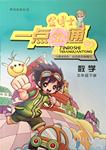题目内容
The first time I remember noticing I remember noticing the crossing guard was when he waved to me as I drove my son to school. He 16 me with a puzzle ---- all because he waved to me like someone does 17 seeing a close friend. A big, 18 smile accompanied his wave. For the next few days I tried to 19 his face to see if I knew him. I didn’t. Perhaps he had 20 me for someone else. By the time I contented myself with the 21 that he and I were strangers, we were greeting each other warmly every morning like old friends.
Then one day the 22 was solved. As I 23 the school he was standing in the middle of the road 24 his stop sign. I was in live behind four cars. 25 the kids had reached the safety of the sidewalk, he lowered his sign and let the cars 26. To the first he waved and 27 in just the same way he had done to me over the last few days. The kids already had the window down and were happily waving their reply. The second car got the same 28 from the crossing guard, and the driver, a stiff-looking(表情刻板的) businessman, gave a brief, almost 29 wave back. Each following car of kids on their way to school 30 more heartily.
Every morning I continued to watch the man with 31. So far I haven’t seen anyone 32 to wave back. I find it interesting that one person can make such a(n) 33 to so many people’s lives by doing one simple thing like waving and smiling warmly. His 34 armed the start of my day. With a friendly wave and smiling face he had changed the 35 of the whole neighbourhood.
16. A. hit B. disappointed C. presented D. bored
17. A. on B. from C. during D. about
18. A. false B. shy C. apologetic D. bright
19. A. research B. study C. recognize D. explore
20. A. praised B. blamed C. mistaken D. respected
21. A. conclusion B. description C. evaluation D. introduction
22. A. argument B. disagreement C. mystery D. task
23. A. visited B. approached C. passed D. left
24. A. drawing back B. putting on C. handing in D. holding out
25. A. Once B. Before C. Unless D. While
26. A. in B. through C. out D. down
27. A. cried B. cheered C. smiled D. gestured
28. A. idea B. reply C. notice D. greeting
29. A. awkward B. angry C. elegant D. patient
30. A. came B. responded C. hurried D. appeared
31. A. surprise B. frustration C. interest D. doubt
32. A. fail B. try C. wish D. bother
33. A. offer B. sacrifice C. promise D. difference
34. A. effectiveness B. cheerfulness C. carefulness D. seriousness
35. A. trends B. observations C. regulations D. feelings
16-20 CADBC 21-25 ACBDA 26-30 BCDAB 31-35 CADBD
解析:
16. 考查动词。根据下文,“he and I were strangers”,但是“he waved to me like someone does on seeing a close friend,”所以这不合常理,“present(呈现,呈送)me with a puzzle”。
17. 考查介词。根据常识,人们一见到亲密朋友就会挥手问候,on doing sth. “一……就”,故选“on”。
18. 考查形容词。和上文 a close friend 相照应,人们见到朋友会呈现“灿烂的”笑容,故选bright“欢快的,兴高采烈的,灿烂的”。
19. 考查动词。因为作者不认识他,所以作者想努力观察他的脸以确定是否认识他。study “仔细端详,仔细察看,研究”。
20. 考查动词短语。 the crossing guard的热情与陌生人的身份不符,所以作者认为他是误把自己当成了别人。
21. 考查名词。作者虽然不理解,但还是高兴地接受了这一“结果”conclusion “结论,结果”, description “描述”,evaluation “评估,评价”,introduction“介绍,引言”。
22. 考查名词。作者之前只能猜想,认为是神秘的事。本题可用排除法,文中不存在argument(争论、辩论),也没有意见上的分歧(disagreement),也不是任务(task)。
23. 考查动词。 根据下文Each following car of kids on their way to school 30,可知是作者送儿子前往学校的路上。approach “靠近,接近”。
24. 考查动词短语。 根据常识,交警指挥交通会举出他的标志牌。draw back “撤退,撤回”, put on “穿上”, hand in “上交”, hold out“伸出,拿出,举出”。
25. 考查连词。他放下标志牌的前提是孩子们到达马路的安全区域,所以选once 引导条件状语从句。
26. 考查介词。车辆是从马路中间穿过,只有through 有此意。
27. 考查动词。 和上文A big, 18 smile accompanied his wave 相照应。
28. 考查名词。向别人微笑和挥手都是一种问候。
29. 考查形容词。 根据上文对businessman 的描述 stiff-looking(表情刻板的), 所以他的挥手是awkward “笨拙的,不灵活的”,elegant“优雅的”,patient “耐心的”。
30. 考查动词。后面的车辆对交警的“反应”更加开心快乐。本题heartily 是副词,故排除A、D, 再根据题意排除C。
31. 考查名词。作者对其产生了好感,故会以感兴趣的眼光来观察他。
32. 考查动词。 此句是双重否定,作者没见到任何不向这个交警回以挥手的人。前已有否定词,只有A选项表否定,fail to do sth.“未能做某事”。
33. 考查名词在固定短语中的意思辨析。 “make a difference” means “to have an important effect on a thing or a situation”(有影响,使不同)。sacrifice(牺牲)不合题意。
34. 考查名词。 effectiveness “有效性”,cheerfulness “快乐,开朗,欣然热情”, carefulness“细心”,seriousness“严肃”。
35. 考查名词和动词搭配。他改变了邻里之间的“感情”,本题考查动宾搭配,其他三项都不能做“改变”的宾语。

 学而优衔接教材南京大学出版社系列答案
学而优衔接教材南京大学出版社系列答案 小学课堂作业系列答案
小学课堂作业系列答案 金博士一点全通系列答案
金博士一点全通系列答案Every year mobile phones develop. Imagining what they will look like and be able to do in 2020 is really a challenge. To help, experts have outlined three major mobile trends that they believe will have become reality by then.
Our phones will be so smart in 10 years’ time that they’ll know everything about our situation and warn us when something needs our attention. This is the top prediction of both Nokia and Google. They predict that our cars and home appliances will be able to communicate with our mobile. For example, fridges will tell your mobile to tell you to pick up milk on the way back from work. While driving, your mobile will suggest that you take a different route because there’s a road accident up ahead.
The second trend is in gesture-based controls. People who know the iPhone’s touch-sensitive screen are already familiar with the technology. It translates hand movements into actions on-screen. But gestural communications will make the phone more convenient to use and may completely replace touchpads. According to industry insiders, the most immediate step forward in gestural technology will be in voice recognition. It’s believed voice recognition technology will speed up communications. It is quicker to speak than type. Eventually, phone screens will disappear.
The third major development will change our understanding of a mobile phone. From a single phone, the mobile will be developed into multi-part devices. It is opposite to the current trend in which mobile phones are combining the functions of cameras, music players and game consoles. The prediction is based on the idea that the world will become more wireless and all these—cameras, music players and game consoles—will be wirelessly connected. Mobile phones won’t need to contain these devices because users will be able to control them wirelessly through their phones.
The first paragraph serves as .
A. a lead-in B. a conclusion C. a summary D. a supporting fact
Which of the following is most likely to be the appearance of a mobile phone in 2020?
 |
From the text, we can learn that the future mobile phones will .
A. drive cars for us
B. be controlled by the users’ voices
C. be controlled by home appliances
D. be very big together with separated multiple parts
The text mainly tells us .
A. three major trends of mobile phones
B. what mobile phones will look like in 2020
C. the future mobile phones are gesture-based
D. some new functions of the present mobile phones